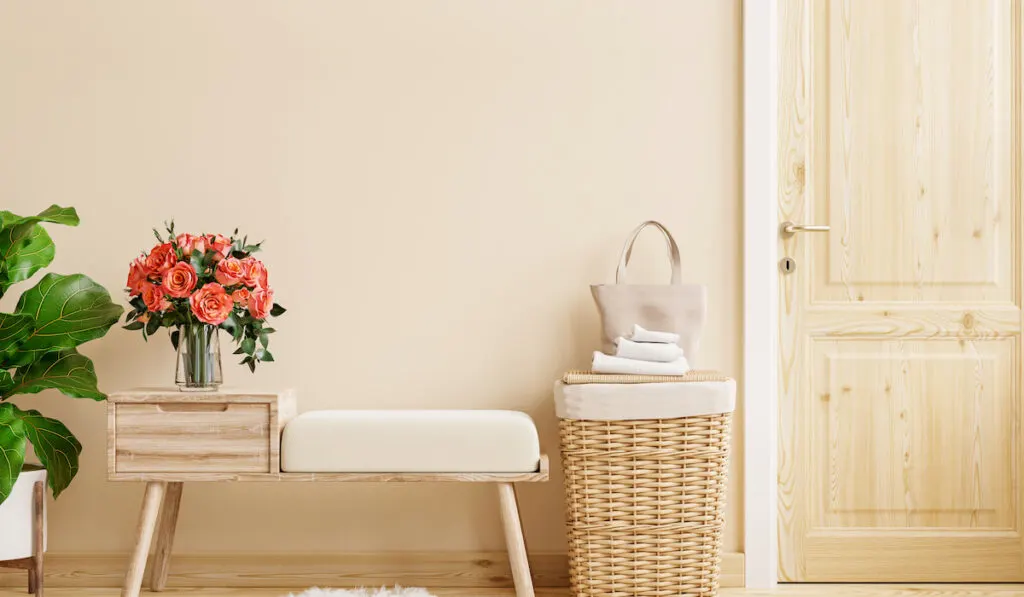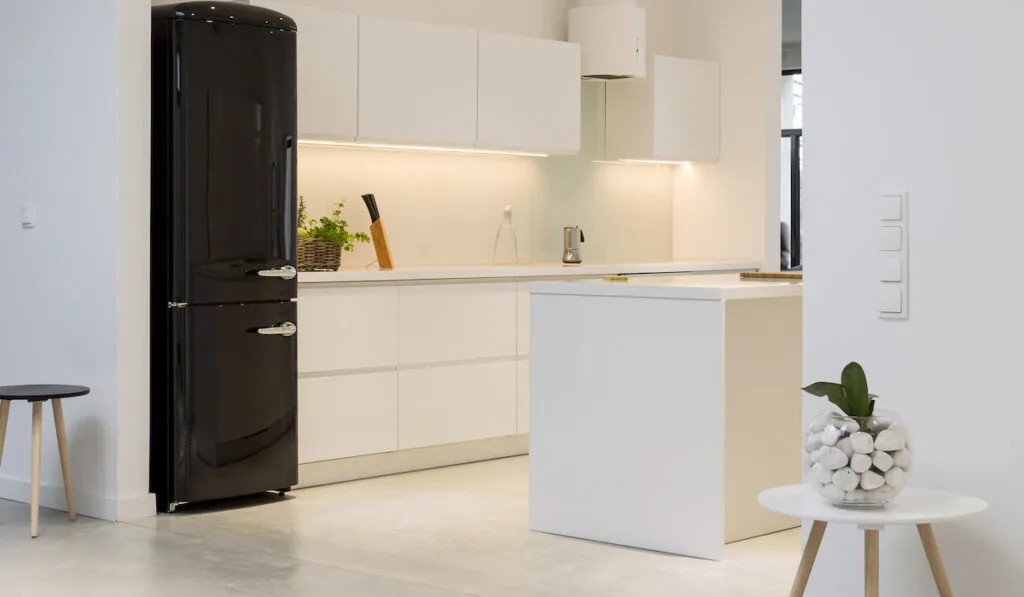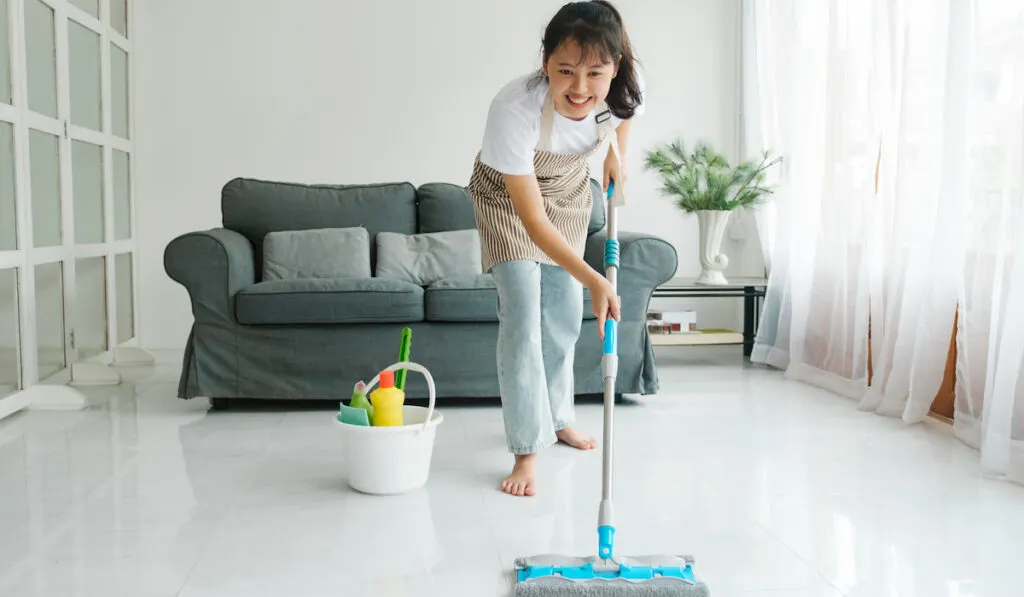Visual clutter can make your home feel imperfect even if you routinely clean and organize. What you can do to improve the situation?
After researching and trying countless tricks, we identified several tips to help you reduce the clutter around your home.
You can reduce visual clutter by replacing packaging materials, clearing surfaces, using organizers, and keeping day-to-day appliances out of sight. Another useful strategy includes being intentional with your decor and furniture pieces.
There are tons of ideas that have proven to be effective in making a space look clutter-free. Below are simple tips you can implement.

Table of Contents
Tip 1: Remove Packaging
Reducing visual clutter can be as simple as replacing the packaging materials of household products. Examples of these products include the following:
- Toilet paper
- Paper towels
- Feminine products
- Soaps
- Laundry and dishwasher detergents
- Groceries
- Pet supplies
These items come with packaging, which may be of different colors, materials, sizes, and shapes. Leaving the products as they are can make your house feel full and cluttered.
We recommend doing away with the packaging and using uniform storage pieces instead.
For instance, sanitary pads can look good in sanitary holders, so can washing detergents look more presentable in customized detergent dispensers.
The following storage items from Amazon.com can change how everything looks around your home:
- For personal sanitary products, use Sanitary Storage Container
- For napkins and paper towels, you can use Napkin Holder, Tray
- You can use Toilet Paper Holder to organize your bathroom tissues
- For groceries, use Clear Storage Bins
- For detergents, use Detergent Dispensers
There are tons of organization products in the market today, so do your due diligence and identify the ones that meet your storage needs and budget.

Tip 2: Clear High-Level Flat Surfaces
Clearing high-level surfaces is a sure way to make your home feel spacious, airy, and clean.
High-level surfaces include countertops, kitchen islands, dresser tops, cabinets, and open shelves.
For these surfaces, try displaying as minimal items as possible. This means doing away with some of the things that you may think are necessary but, in reality, are only filling up the space, making them look busier than they should.
To do this, assess these surfaces for items you don’t use 24/7 and keep those items in an enclosed space where they are out of sight.
For instance, in the kitchen, these items could include appliances like a frother, mixer, kettle, blender, and serving pieces.
While these gadgets are functional, they may clutter your kitchen countertop, leaving you little space to prepare your meals.
Watch this video to learn more about kitchen organization:

Tip 3: Be Intentional About Your Decor
When it comes to furniture and decor, it may be tempting to buy everything that looks attractive.
However, if you closely assess your household purchases, you’ll realize you don’t need some of the pieces you buy.
Making unnecessary purchases only fills your space in the long term, which adds to visual clutter.
This is why we recommend only purchasing what is functional and purposeful.
A rule of thumb is to delay your purchase for a few days or weeks to see if you still need the item. This will help you make informed decisions when purchasing decor or big furniture.
You’ll be able to identify a location for the item and visualize how you want it to look once you’ve brought it home.

Tip 4: Find a Designated Home for Day-to-Day Items
Another pro tip you want to consider is where you place small items such as your keys, wallet, work badge, sunglasses, and headphones.
Doing so will help if you identify a safe space for these items, as they can easily get misplaced.
If you have an entryway table, you can place an organizer there to store these items.
This will make it easier for you to locate what you need when needed.
Likewise, shoes can also be another culprit of clutter, especially when you leave them at the door.
You can solve this problem by using a small entryway shoe storage organizer that is both functional and clutter-free, such as the ones listed below:

Tip 5: Use Organizers
Organizers can never get outdated. They can add life to your space if you strategically use them to store free-standing items.
From your kitchen to your bedroom, living room, and bathrooms, using organizers can help you save space in ways you never imagined.
You can start with using functional clutter bins, baskets, or bags to store items that lie around. These could include toys, electrical cables, throw pillows and throw blankets you don’t use, and kitchen appliances and groceries.
You can improve the aesthetic appeal of these organizers by storing a group of items in one bin.
You can make your work easier by placing these items where they are easily accessible.

Tip 6: Label Things
After organizing several items into groups, you can go a step further to label them for easier identification when you need them.
Labeling containers will make it easier for you and your loved ones to return things after you’re done using them.

Tip 7: Don’t Use Your Fridge to Display Things
Having items of different colors and materials on your fridge can make the space disorganized and too busy.
Additionally, affixing and removing things like magnets, tape, and other adhesives on the fridge can damage the exterior.

Tip 8: Store Appliances Away
It’s easier to let appliances lie around when you’ve finished using them. However, this only contributes to the clutter in the spaces.
Appliances that are not in use usually take up valuable space and make the room look cluttered. Storing them frees up the space and creates a more organized look.
In this case, you can implement several ideas, including storing the appliances in cabinets with doors and drawers. You can also use an appliance garage if you have one.

Tip 9: Don’t Neglect Your Floor
Dirty floors can make your home feel messy and chaotic. Cleaning the floors makes a lot of difference.
It’s possible to achieve the above by vacuuming or deep cleaning regularly to remove dust and debris.
Also, mopping and scrubbing the floors, depending on your flooring, can be a good way to remove stubborn stains, creating a polished look.
Remove items lying on the floor to free up the space, which is one way to achieve a relaxing and inviting environment.

Tip 10: Wipe Down Your Surfaces
Untouched surfaces harbor grime, dirt, and dust over time. The accumulation of these substances can create a dirty appearance, which can contribute to visual clutter.
Regularly wiping surfaces is one way to make your home look and feel clean. You may use a microfiber cloth and the ideal surface cleaner to clean the surfaces effectively.
Pay attention to high-traffic areas, such as kitchen and bathroom countertops and sinks, study tables, coffee tables, and bathroom tiles.
These areas are likely to get dirty easily, so regularly working on them can significantly help to reduce the visual clutter.

Tip 11: Clear the Kitchen Sink
Leaving dirty dishes in the sink, countertop, or on the table can be tempting, but it creates visual chaos.
Kitchens are meant to be enjoyed, so doing the dishes soon after a meal can keep your kitchen tidy.
Other than that, putting the clean dishes away, out of sight, is an ideal way to clear the counters, making the area look less cluttered.
If you do the dishes routinely after eating or preparing a meal, you might feel motivated to organize and clean other areas of your home.
Conclusion
You don’t need much to create a clean and homely space. You can significantly improve the visual appeal of several areas of your home using different strategies, such as the following:
- Cleaning surfaces
- Clearing the kitchen sink
- Using organizers
- Being intentional with your decor
- Storing appliances
The tips discussed above can help you enjoy an elegant and clutter-free home. However, be intentional when decluttering to maintain or improve the functionality of each area.
Resources:
- https://www.thespruce.com/what-to-store-on-kitchen-counters-2648141
- https://www.familyhandyman.com/list/label-ideas-tips-for-organizing-with-a-label-system/
- https://birchtreeorganizing.ca/organizing-favourites-7-benefits-of-organizing-with-labels/
- https://sweethomecleaningservice.com/4-tips-for-keeping-high-traffic-areas-clean/
- https://schoolofdecorating.com/2012/09/10-strategies-to-avoid-unnecessary-home-spending/
